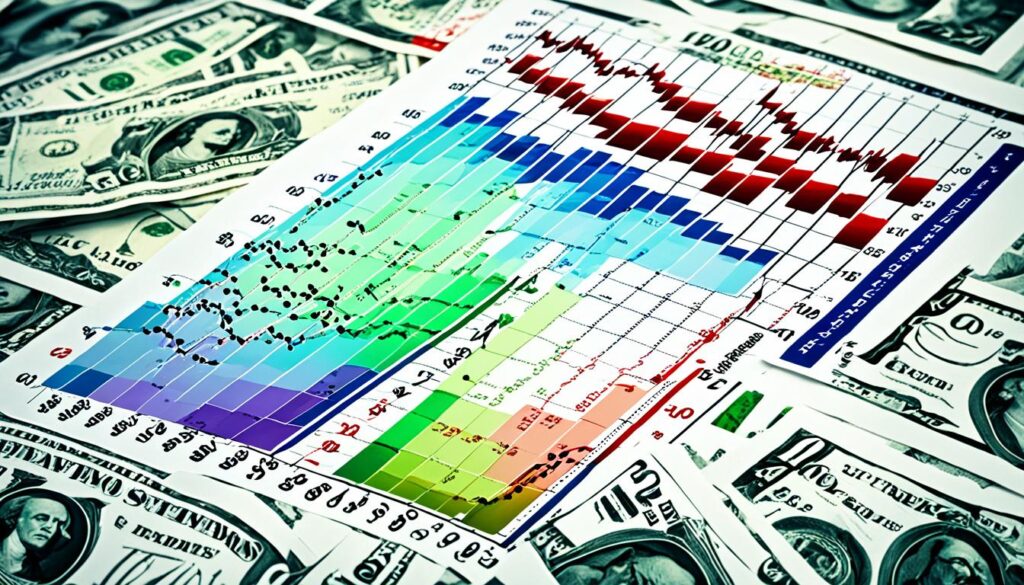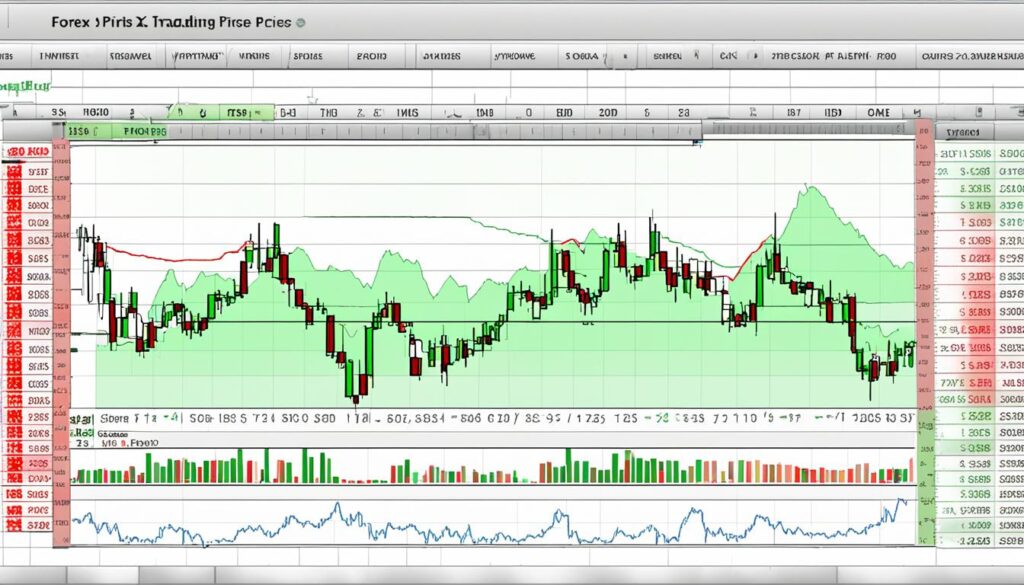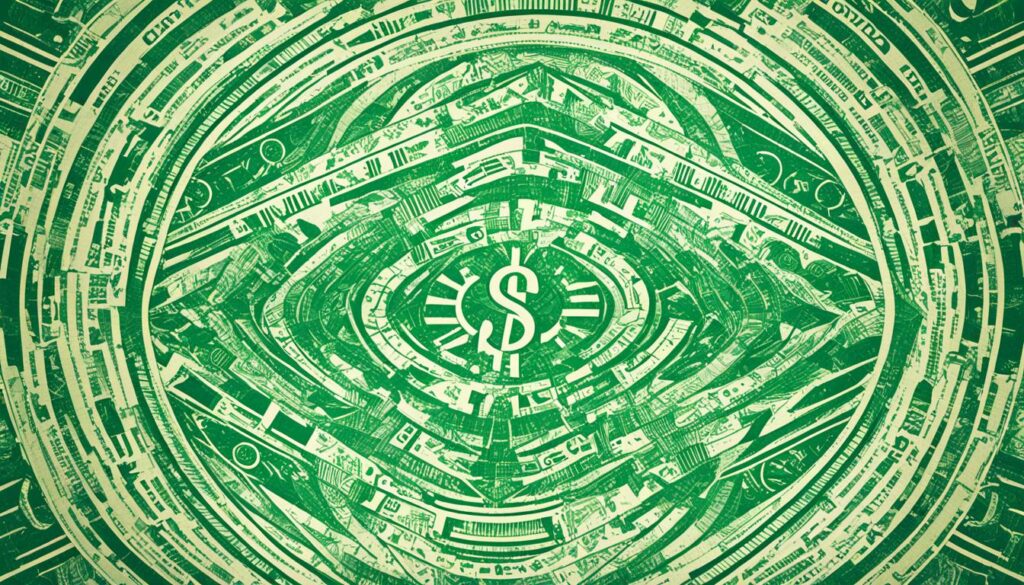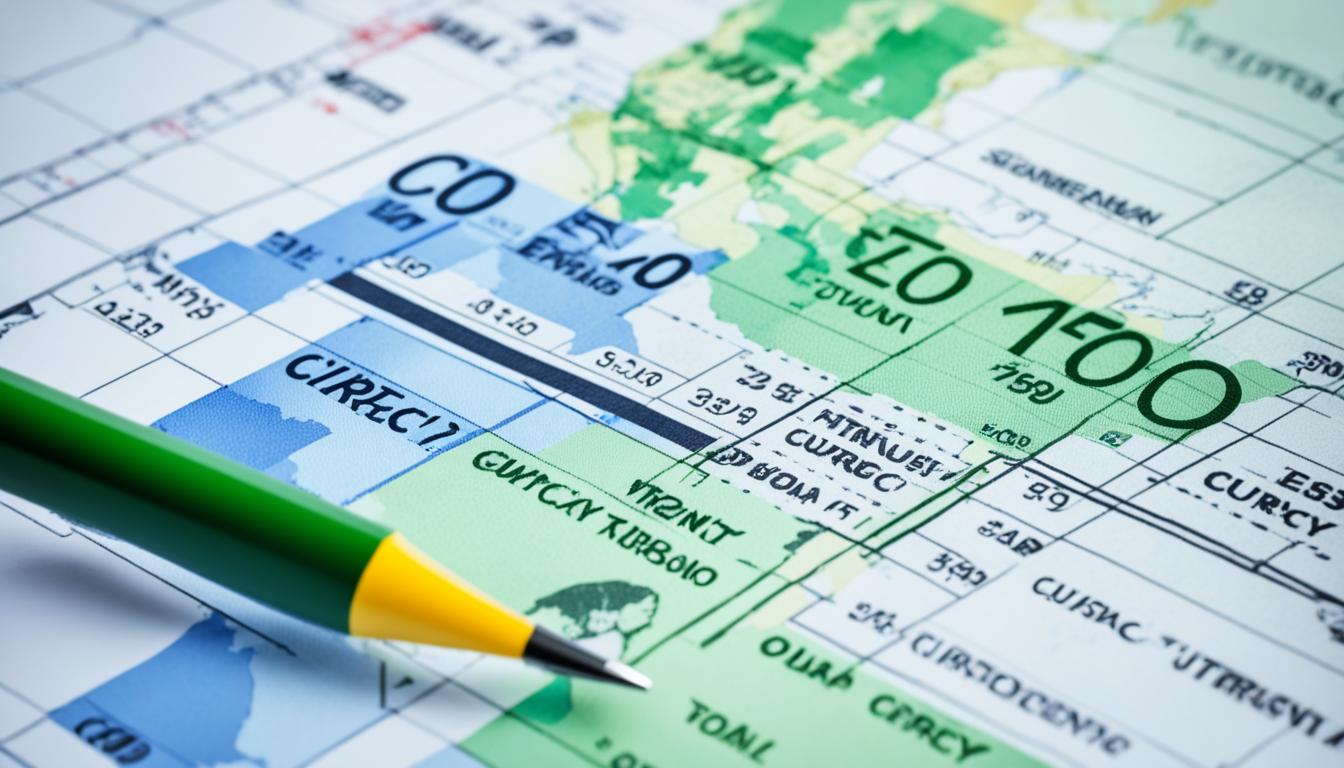What is the Quote Currency in Forex Trading?
Trillions of dollars are traded daily in the foreign exchange market, making it highly liquid. In 2023, currency pairs like EUR/USD, USD/JPY, and GBP/USD were the main focus. But what really pushes these trades? Understanding the role of the quote currency is key.
The quote currency, also known as the counter currency, comes second in currency pairs. It sets the base currency’s value, which is listed first. Take the GBP/USD pair, for instance. Here, GBP is the base currency and USD is the quote currency. The exchange rate shows how much quote currency you need to buy one unit of the base. This knowledge is critical for trading wisely.
Key Takeaways
- Trillions of dollars flow through the foreign exchange market each day, making it very liquid.
- The quote currency’s value helps determine the base currency.
- EUR/USD, USD/JPY, and GBP/USD were popular pairs in 2023.
- Knowing currency quotes indicates the amount of quote currency for a base currency unit.
- Forex trading happens around the clock, five days a week.
Understanding the Basics of Forex Trading
The foreign exchange market, or Forex, is where a lot of money, averaging $7.5 trillion, changes hands in 2022. It works 24/5, across big cities like London and New York. People trade all day and night, buying and selling different country’s money. This happens because it’s easy to quickly change money into other currencies.
Definition of Forex Trading
Forex trading is buying one currency while selling another to make a profit from changes in their values. For example, you might buy Euros using U.S. dollars with the hope that the Euro will become worth more. It’s a way to make money by looking at the news, like economic updates and world events, to predict which currencies will grow in value.
There are many ways to trade currencies, such as cash (spot) deals or through future agreements. This variety makes it possible for people to take different approaches, depending on their goals. Some people are trying to guess which way the currency market will move. Others are merely trying to protect themselves from sudden changes in currency values.
How Forex Trading Works
When trading Forex, you always work with currency pairs. One popular pair is the Euro against the U.S. dollar. To trade this pair, you’d buy Euros and simultaneously sell dollars. The goal is always to make a profit based on how these two currencies change value relative to each other.
The market is very liquid, which means you can easily buy or sell a lot without changing the prices much. This makes it easier for people to trade, whether they’re trying to make a quick buck or are investing for the long term.
There is a wide range of things you can trade on the Forex market, not just national currencies. You can trade on CFDs, indexes that reflect certain parts of the economy, commodities like gold and oil, and even digital currencies. This gives both small and big traders a lot of options for where they want to put their money.
Today, almost anyone can get into Forex trading, not just big institutions. It’s opened up to the general public, making up about 5.5% of all trading. This has changed who gets to play in the currency market and how it all works.
| Asset Type | Description |
|---|---|
| Currencies | Primary asset in forex trading, exchanged in pairs |
| CFDs | Leveraged products allowing speculation on price movements of various assets |
| Indexes | Represents a portfolio of securities that mirrors a segment of the financial market |
| Commodities | Physical assets such as gold, silver, oil trading on forex markets |
| Cryptocurrencies | Digital or virtual currencies traded on forex platforms |
What is the Quote Currency?
In forex trading, the quote currency is crucial. Since currencies trade in pairs, it shows how much of a currency you need to purchase another. This is important for setting exchange rates and making trading choices.

Role of the Quote Currency
The quote currency in a pair sets the base currency’s value. For example, in EUR/USD, EUR is the base and USD is the quote. The exchange rate shows the cost in US dollars to buy one euro. Traders need to understand this to trade effectively.
Direct and Indirect Quotes
Forex uses both direct and indirect quotes. In a direct quote, the foreign currency is the quote. For a US trader, buying euros might be EUR/USD 1.1404. An indirect quote is the opposite.
Most forex pairs with USD place it in either spot, making these concepts crucial for trading. Also, international companies use these quotes to set their prices in foreign markets.
Significance of Currency Pairs in Forex Trading
Currency pairs are key in forex trading. They are the backbone of every trade. Knowing about these pairs helps traders make smart choices.
Base Currency vs. Quote Currency
Each currency pair has a base and a quote currency. The base comes first, followed by the quote. Take EUR/USD for example. Euro is the base and the U.S. dollar the quote. It shows the price in dollars to buy one euro.
The base currency is always first. Understanding this is crucial. The price of the quote currency is in terms of the base. Changes in rates show the base currency’s value changing against the quote. This can be due to economic news or decisions from central banks.
Common Currency Pairs
Major forex pairs like EUR/USD are very popular. It’s the most traded pair. USD/JPY is next, and they include the U.S. dollar. Some examples:
- EUR/USD
- USD/JPY
- GBP/USD
- USD/CHF
- AUD/USD
- USD/CAD
There are also minor pairs, known as crosses. They don’t have the U.S. dollar and usually have wider spreads. For example:
- EUR/JPY
- EUR/GBP
- NZD/USD
Exotic currency pairs offer something different. They are less common and come from emerging markets. They have less liquidity and wider spreads. Examples include USD/CNY and USD/TRY.
| Category | Currency Pair | Liquidity | Spread |
|---|---|---|---|
| Major Currencies | EUR/USD, USD/JPY | High | Tight |
| Minor Currencies | EUR/GBP, EUR/JPY | Medium | Slightly Wide |
| Exotic Currencies | USD/CNY, USD/TRY | Low | Wide |
How Exchange Rates Are Determined
The Forex market sees exchange rates change all the time. There are many reasons why this happens. It’s vital for traders, big or small, to know what influences these changes.

Factors Influencing Exchange Rates
Economic activity, interest rates, and the geopolitical environment really matter. Central banks across the globe, with their big financial moves, shape currency values. For instance, changes made by the Federal Reserve can cause the U.S. dollar’s worth to go up or down.
The well-being of a country’s economy, its growth, and inflation all play a role too. These things decide how powerful a country’s currency is around the world.
Big world events also make a difference. Take the Brexit vote in June 2016, for example. The British pound quickly lost value against the U.S. dollar after that.
Supply and Demand Dynamics
Exchanging currencies is like buying and selling anything else: supply and demand are key. When more people want a currency, its value goes up. But if there’s more of that currency available, it becomes less valuable.
Some countries keep their currency values steady with special policies. For instance, the Hong Kong dollar is always worth a set amount in U.S. dollars. This keeps its value from changing suddenly. China does something similar, making sure the yuan doesn’t move too much in value each day.
With more than $6 trillion changing hands each day, these factors all mix together. This means that traders have to think about economic activity, interest rates, and the geopolitical environment very carefully.
| Currency Pair | 2024 Exchange Rate |
|---|---|
| USD/EUR | 1.07 |
| HKD/USD | 7.75-7.85 |
| GBP/USD | 1.30 (post-Brexit) |
By understanding all these factors, traders can get a better grasp of the market. This knowledge helps them make smarter choices in this fast-moving market.
Trading Strategies Using Quote Currencies
Forex traders use different methods with quote currencies to either make money from market changes or lower risks. They work through speculative trading and hedging. You need to fully get the base versus quote currency relationship for these to work well.
Speculative Trading
Speculative trading means trying to guess when currency values will change and making money from that. Traders often use technical analysis to predict prices. They use things like moving averages, RSI, and Bollinger Bands to help them decide what to buy and sell.
If the market is very up and down, it can be hard to trade this way. Big shifts in value might come from things like economic reports, politics, or central bank moves. So, traders should have strong plans for managing risks.
Hedging and Risk Management
Hedging, on the other hand, aims to protect against losing money when exchange rates don’t go your way. Businesses that trade globally often hedge their bets for a more secure financial future. This is especially key with exotic pairs because the cost to trade can change a lot.
Central banks also change how much money currencies are worth. Actions on interest rates and QE can shake up the markets. Good hedging strategies are necessary to deal with these changes.
It’s important for both traders and businesses to watch out for thinking traps like only seeing what you want to see or being too sure of yourself. Avoiding these traps can make trading and hedging more successful, leading to more steady financial gains.
Understanding Bid-Ask Spreads
The bid-ask spread is the difference between a dealer’s buying and selling currency price. It plays a big role in Forex trading. This difference can change how much you spend and earn in trade deals.
Knowing how the bid and ask prices work is key for traders, no matter their skill level.

Bid Price
Buyers set the bid price by offering what they’re willing to pay for currency. This rate can change a lot in a day, affected by market volume and economic news. A close bid-ask spread means it’s easier and cheaper to make trades, showing the market is more active.
| Currency Pair | Typical Bid-Ask Spread | Market Condition |
|---|---|---|
| EUR/USD | 1-5 pips | High Liquidity |
| GBP/JPY | 10-20 pips | Moderate Liquidity |
| EUR/GBP | 3-6 pips | High Liquidity |
Ask Price
The ask price is what sellers want for their currency. Understanding this can help you make smarter trade choices. In markets with fewer trades, you can see larger spreads. This might cost you more and be riskier in unstable times.
Currency sellers may offer you different prices, even in the same area. So, it’s smart to shop around for the best rates. Currency stands at airports often have higher spreads, meaning you could get a lot less for your money.
These differences in rates affect how trades go down. Watching bid-ask spreads closely can help traders find better deals. This knowledge lets them make wiser choices, leading to better financial results.
Learning these trading basics is crucial for anyone wanting to succeed in Forex. It can mean more money in your pocket when you know how to navigate the market.
Impact of Leverage and Margin Trading
In Forex, leveraging capital boosts a trader’s gains but also risks bigger losses. Leverage lets traders control big positions with little capital.
Definition of Leverage
Leverage means using a ratio to open positions. For example, a 2% margin lets you control $50 with every $1. This high leverage is unique to Forex, where it can be as high as 100:1.
Risks Involved with Leverage
While leverage can increase profits, it also means facing bigger risks. If the market moves against you, you might have to pay more money. This could lead to losing more than you initially invested.
A 50:1 leverage on a $10,000 trade could lose 25% of your account with a small 50 pip loss. But, using only 5:1 could limit this loss to just 2.5%.
Margin Trading Explained
Margin trading lets you open positions by committing only a fraction of its total value. This is known as the margin. A 2% margin means you control a $100,000 position with just $2,000.
It’s important to use low leverage and beware of changing margin requirements. Using stops can help prevent big losses.
It’s crucial to use stops smartly and avoid risky practices. Trusted firms like Charles Schwab Futures and Forex LLC can offer guidance on safe trading.
| Leverage Ratio | Position Value | Potential Loss (50 Pips) | Impact on Account |
|---|---|---|---|
| 50:1 | $500,000 | $2,500 | 25% |
| 5:1 | $50,000 | $250 | 2.5% |
Role of Central Banks and Economic Indicators
Central banks are key in the Forex market. They use monetary policy and change interest rates. Sometimes, they act directly to keep currency values steady. These moves really shape the exchange rates we see. For instance, when a bank like the Federal Reserve lifts rates, that currency might become stronger. This happens as more investors show interest in big returns. It changes how much of a currency people want and need.
- Influencing monetary policy
- Adjusting interest rates
- Direct interventions
Economic indicators also play a huge part in setting currency values. Things like GDP growth, job numbers, prices, and trade info matter a lot. Let’s say there’s a strong report about GDP growth. That often means the economy is doing well. It draws in foreign investors and raises the demand for the country’s currency. But if the economic news is bad, it can make the currency weaker. Investors might lose some trust in it.
“The importance of economic indicators like GDP growth and employment statistics cannot be overstated. They provide a snapshot of a country’s economic health and influence investor sentiment significantly.”
Knowing how economic clues link with central bank moves is really useful for traders. To get in-depth knowledge, checking out economic reports and keeping an eye on what central banks are up to is smart. This helps you make wiser trading choices.
Quote Currency in Forex Trading
In the exciting world of Forex trading, understanding the quote currency is key. It helps traders evaluate currency trades accurately. Knowing how the quote currency and base currency interact gives insights into market movements.
The quote currency is vital in Forex analysis. It’s the second currency in a pair and shows how much you need of it to buy the first currency. For example, in EUR/USD, the USD shows how many US dollars buy one euro.
Forex never sleeps, allowing constant trade evaluations. 90% of trades are done with only 14 currencies. This shows the importance of these major currencies, like the US Dollar and Euro. Major pairs like EUR/USD, USD/JPY, or GBP/USD are active, making up 77% of trades.
Learning about the quote currency can greatly impact trading. The value of a pip, the smallest price unit, changes with the quote currency. For most rates, we look at the fourth decimal, but for Yen, it’s the second. These small changes matter, especially in large trades.
Let’s dive deeper into Forex quotes with the spread. This is the gap between the buy and sell prices, usually in pips. Brokers can set fixed spreads, adding complexity to trade costs and profits involving specific currencies.
| Currency Pair | Bid Price | Ask Price | Spread (Pips) |
|---|---|---|---|
| EUR/USD | 1.1750 | 1.1752 | 2 |
| USD/JPY | 109.75 | 109.77 | 2 |
| GBP/USD | 1.3745 | 1.3748 | 3 |
| USD/CHF | 0.9240 | 0.9243 | 3 |
Having a deep understanding of quote currencies helps traders. It enables them to make better choices that fit their goals and risk. Observing how quote currencies react to the economy aids in predicting price movements, a crucial forex skill.
Conclusion
Understanding the *quote currency* in Forex trading is key for any trader. It is important to grasp the role of the quote currency and learn about currency pairs and exchange rates. The Forex market changes a lot, so it’s crucial to keep up with economic news and world events. These can affect the value of currencies.

TIOmarkets is chosen by over 170,000 traders in 170 countries. They like the 300+ instruments across 5 markets, and options like algorithmic trading. This type of trading uses set rules for buying and selling, which can include Arbitrage and Machine Learning strategies.
Traders need to know about the high risks of CFDs and how to manage these risks. The Forex market was worth $805 billion in 2023. It’s a big market, especially for trading the most liquid pairs like EUR/USD.
Traders use strategies that follow how the quote currency moves. They might do this to make bets or to protect their investments. Knowing how to use leverage up to 100:1 and understanding margin trading is important. It’s also key to remember that the USD, EUR, and GBP can be the main currencies in different trading situations.
Knowing about the quote currency helps traders plan for wins and losses. Since 88% of Forex trading deals involve the USD, knowing about bid-ask spreads is very useful. These insights give traders an advantage in the fast-moving Forex market.
| Aspect | Insight |
|---|---|
| Traders | 170,000+ across 170 countries |
| Instruments | 300+ |
| Markets | 5 |
| Market Value (2023) | $805 billion |
| Top Trading Pairs | EUR/USD, USD/JPY, GBP/USD |
| Leverage | Up to 100:1 |
| Forex Transactions Involving USD | 88% |
Insights into the Forex market are crucial for smart trading moves. They help traders build effective strategies and take a broad view of trading in foreign currencies.
Final Thoughts on the Forex Market
To wrap up our look at forex trading, let’s focus on its main ideas. Trading involves buying one currency and selling another. This basic move is a key strategy for those interested in the future of money trading. Big pairs like EUR/USD and USD/JPY are popular because they are easy to trade. Figuring out how the base and quote currencies affect each other is crucial for smart trading.
Tackling the forex market means understanding bid and ask prices well. Reading these prices, along with trends and technical analysis, helps traders decide wisely. Detailed quotes, sometimes with four or five decimal places, are important for experts in forex trading. The difference between bid and ask prices, known as the spread, shows the costs of trading and can hint at market feelings.
Having a reliable brokerage account is vital for forex trading, such as those offered by Charles Schwab Futures and Forex LLC. This kind of account is needed for managing investments and using advanced trading techniques. Despite the risks from market changes, being well-informed can lead to big wins. It’s critical to watch economic news and central banks. This helps traders stay ready for the market’s twists and turns, leading to a smarter and more complete approach to trading.
